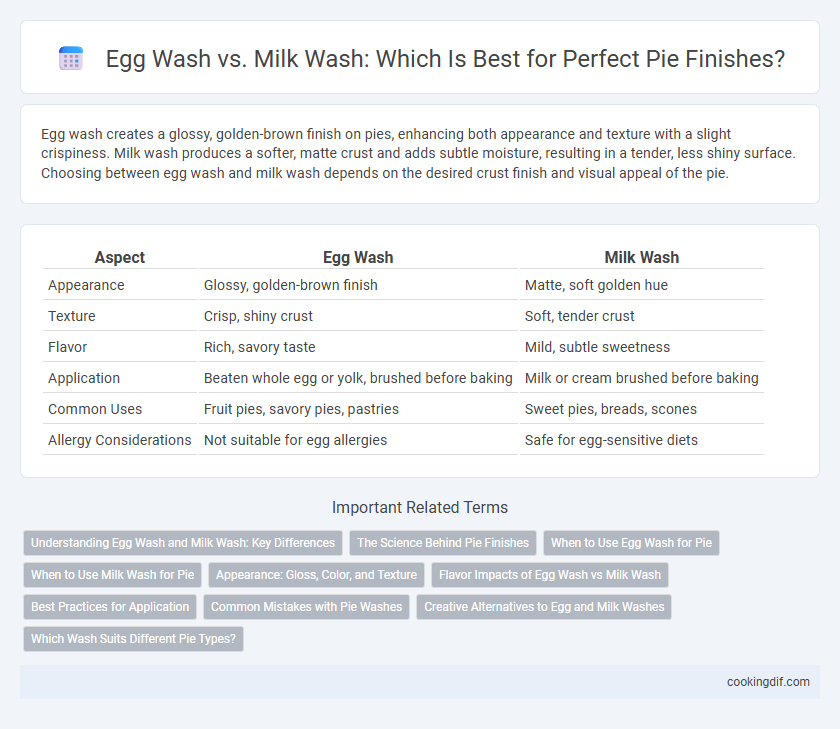Egg wash creates a glossy, golden-brown finish on pies, enhancing both appearance and texture with a slight crispiness. Milk wash produces a softer, matte crust and adds subtle moisture, resulting in a tender, less shiny surface. Choosing between egg wash and milk wash depends on the desired crust finish and visual appeal of the pie.
Table of Comparison
| Aspect | Egg Wash | Milk Wash |
|---|---|---|
| Appearance | Glossy, golden-brown finish | Matte, soft golden hue |
| Texture | Crisp, shiny crust | Soft, tender crust |
| Flavor | Rich, savory taste | Mild, subtle sweetness |
| Application | Beaten whole egg or yolk, brushed before baking | Milk or cream brushed before baking |
| Common Uses | Fruit pies, savory pies, pastries | Sweet pies, breads, scones |
| Allergy Considerations | Not suitable for egg allergies | Safe for egg-sensitive diets |
Understanding Egg Wash and Milk Wash: Key Differences
Egg wash, composed of beaten eggs or egg yolks, provides a rich, glossy, and golden-brown finish to pie crusts, enhancing color and shine through protein and fat content. Milk wash, made from whole milk or cream, imparts a softer, matte finish with a lightly browned surface due to lactose sugars caramelizing during baking. The choice between egg wash and milk wash affects not only appearance but also texture, with egg wash creating a firmer crust and milk wash offering a tender, subtle crust finish.
The Science Behind Pie Finishes
Egg wash creates a glossy, golden-brown crust on pies due to the Maillard reaction, where proteins and sugars react under heat. Milk wash, containing lactose and proteins, promotes browning through caramelization but yields a softer, less shiny finish. Understanding these chemical reactions helps bakers choose egg wash for a crisp, shiny crust or milk wash for a tender, matte appearance.
When to Use Egg Wash for Pie
Egg wash is ideal for pie finishing when a glossy, golden-brown crust is desired, as its protein content promotes browning and adds a shiny finish. It is particularly useful for fruit pies, savory pies, and those with intricate lattice tops that benefit from enhanced visual appeal. Applying egg wash before baking also helps toppings like sugar or seeds adhere better, improving texture and presentation.
When to Use Milk Wash for Pie
Milk wash is ideal for pie crusts that require a softer, more tender finish with a subtle golden color, enhancing the crust's moisture without adding shine. Use milk wash on fruit pies, custard pies, and savory pies where a gentle browning and slightly matt texture complement the filling. Applying milk wash before baking helps achieve a delicate crust that balances crispness and moisture, perfect for flaky or crumbly pie dough.
Appearance: Gloss, Color, and Texture
Egg wash provides pies with a rich golden-brown color and a glossy, slightly crisp texture due to the proteins and fats that caramelize during baking. Milk wash yields a softer, matte finish with a lighter brown hue and a tender, less crunchy crust. Choosing between egg wash and milk wash depends on the desired visual appeal and texture of the pie's surface.
Flavor Impacts of Egg Wash vs Milk Wash
Egg wash enhances pie crust flavor by imparting a rich, savory depth and creating a glossy, golden-brown finish, especially when mixed with a pinch of salt or sugar. Milk wash offers a subtler, milky sweetness with a softer sheen, making the crust tender but less pronounced in flavor. Choosing between egg wash and milk wash directly affects the pie's visual appeal and flavor intensity, with egg wash delivering a more robust taste profile.
Best Practices for Application
Applying an egg wash to pie crusts creates a glossy, golden-brown finish that enhances both appearance and texture, especially when using whole eggs or egg yolks diluted with water. Milk wash, typically applied with a soft brush, produces a softer, matte crust with a tender bite, making it ideal for sweeter or fruit pies. For best results, apply the wash evenly before baking, avoiding pooling on the surface to prevent uneven browning or dripping.
Common Mistakes with Pie Washes
Using egg wash for pie finishing often leads to overly dark or uneven browning due to excessive application or insufficient whisking, which causes streaks and a greasy texture. Milk wash, while providing a softer shine and golden color, is frequently misused when applied too thickly, resulting in a gummy or blotchy crust instead of a smooth finish. A common mistake in both washes is neglecting to brush consistently and evenly, which affects the pie's aesthetic appeal and overall texture.
Creative Alternatives to Egg and Milk Washes
Using alternatives like melted butter or cream for pie finishing creates a rich, golden crust with a tender texture. Brushing pies with maple syrup or honey enhances sweetness and adds a natural sheen without relying on eggs or milk. For a vegan option, aquafaba--chickpea brine--provides a glossy finish similar to egg wash while maintaining moisture and improving browning.
Which Wash Suits Different Pie Types?
Egg wash provides a glossy, golden-brown finish perfect for fruit pies and savory meat pies, enhancing their visual appeal and creating a slightly crisp texture. Milk wash offers a softer, matte sheen ideal for custard and cream pies, as it adds subtle browning without overpowering delicate fillings. Selecting the right wash depends on the pie type and desired crust texture, with egg wash best for robust pies and milk wash preferable for tender, creamy varieties.
Egg wash vs Milk wash for pie finishing Infographic

 cookingdif.com
cookingdif.com